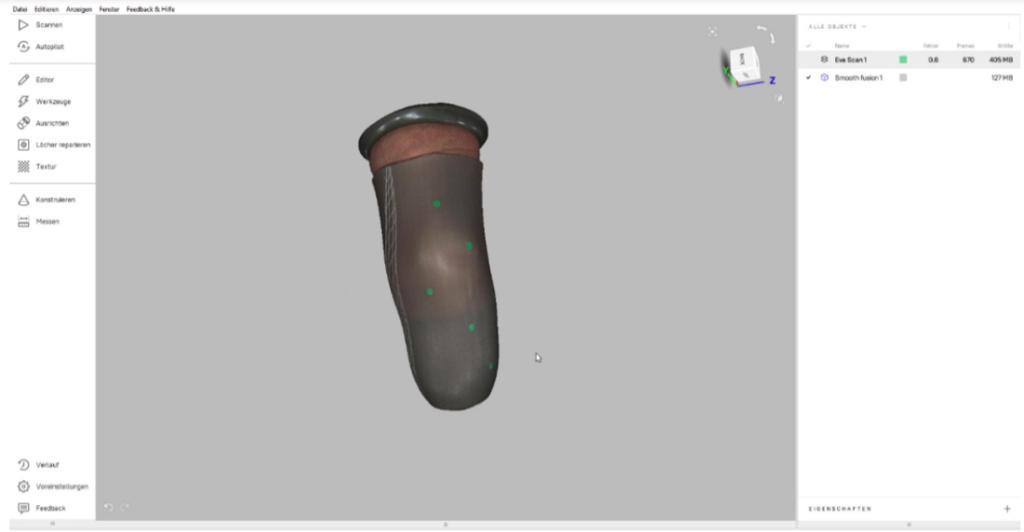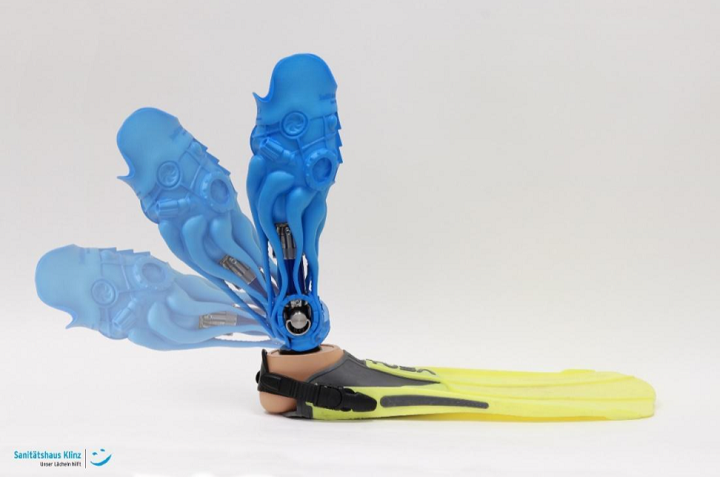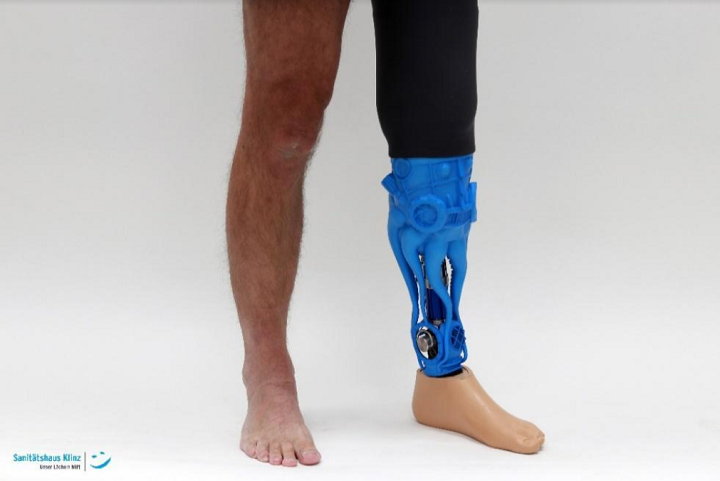Worldwide demand for prosthetic specialists is rising, and for good reason: each year in the US, over 150,000 people undergo lower limb amputations, and while that number is considerably lower in Germany, there are still thousands of people in that country annually who lose a lower limb. One example is Wolfgang K., who was unloading his delivery truck in central Germany when the forklift that was supposed to carry his boxes away instead crashed into him, knocking him unconscious and shattering his left foot. Doctors tried for three years to save his foot, before the inflammation spread so far up his leg and caused so much tissue necrosis that they were forced to amputate his leg below the knee.
Once the swelling went down, Wolfgang was fitted for a transitional prosthesis, and soon became a patient of the Sanitätshaus Klinz orthopedics clinic in Bernburg. The specialists at the clinic still use traditional methods, like plaster casting, in their work, but sometimes for special cases, they employ the professional, handheld Artec Eva 3D scanner, which I had the pleasure of reviewing this year and has been used for medical applications in the past.
“We dealt with scanners and software 6 years ago and tested various scanners. For us, Artec scanners and Artec Studio have established themselves. They work quickly, reliably and very precisely. We now have two Artec Eva and one Artec Spider, which we use for different applications,” Lisa Pabst, a biomedical engineer at Sanitätshaus Klinz, told 3DPrint.com. “We have tried several scanners over the years, but have stuck with Artec products.”
Sanitätshaus Klinz created several prostheses for Wolfgang before he needed a new customized bath prosthesis that could not only be used in the shower, but also for swimming in the ocean. Pabst knew from speaking with him that Wolfgang had a passion for diving, which meant that the prosthesis needed to be waterproof and corrosion-resistant in salt water.
Together, the two worked with master orthopedic technician Carsten Suhle to develop a unique, daily-use prosthesis featuring a functional maritime design with, according to an Artec 3D case study, “the esthetics of a cosmetic prosthesis, so when it’s being worn under long pants, no one can tell that there’s a prosthetic limb underneath.” A swimming flipper can also be attached to the prosthesis.
“The brainstorming started after the patient gave us his “go” for a somewhat more unusual prosthesis. The new prosthesis should be a bath prosthesis with a special joint in which the prosthetic foot can be angled. So it is possible for him to wear flippers on both sides for his hobby, diving,” Pabst told me.
“Initially, the ideas came down to a design with oxygen bottles, tubes, swimming goggles and other diving gadgets. But we wanted to pursue a new approach and asked ourselves whether it would also be possible to integrate a prosthesis into a design and not adapt the design to the prosthesis. After further consideration of a maritime design, we came up with the idea of using an octopus. The body of the squid covers the prosthesis shaft well and thanks to the tentacles an approximate shape of the contralateral lower leg can be reproduced. To round off the concept and to get back to the diving theme, a nostalgic diving helmet, around which it wraps its tentacles, was added to the octopus. This diving helmet also hides the ankle of the prosthesis. The joint can be operated through the opening of the helmet.”
The most important part of a prosthesis is the fit and shape of its socket, because even the smallest issue can cause discomfort, biomechanical dysfunction, and even issues as severe as impaired balance, skin ulcers, osteoarthritis, and chronic musculoskeletal overuse injuries. This is where the Artec Eva is helpful, as Pabst was able to quickly scan the surface geometry of Wolfgang’s residual limb, as well as the other leg—allowing the team to use its precise volumetric and surface measurements to create the dimensions and shape of the new prosthesis.
The Eva scans were processed using Artec Studio software, which allowed Pabst to delete unwanted data and apply texture, before exporting the 3D meshes of the prosthetic socket to Geomagic Freeform for digital sculpting.
“The patient’s stump was scanned with the Artec Eva scanner and Artec Studio 15. After the raw data from the scan had been combined to form a fused object, the model was post-processed and the prosthesis was designed in Geomagic Freeform, a software from 3D Systems. The special thing about the software is the haptic input device, which provides direct feedback when designing,” Pabst told me.
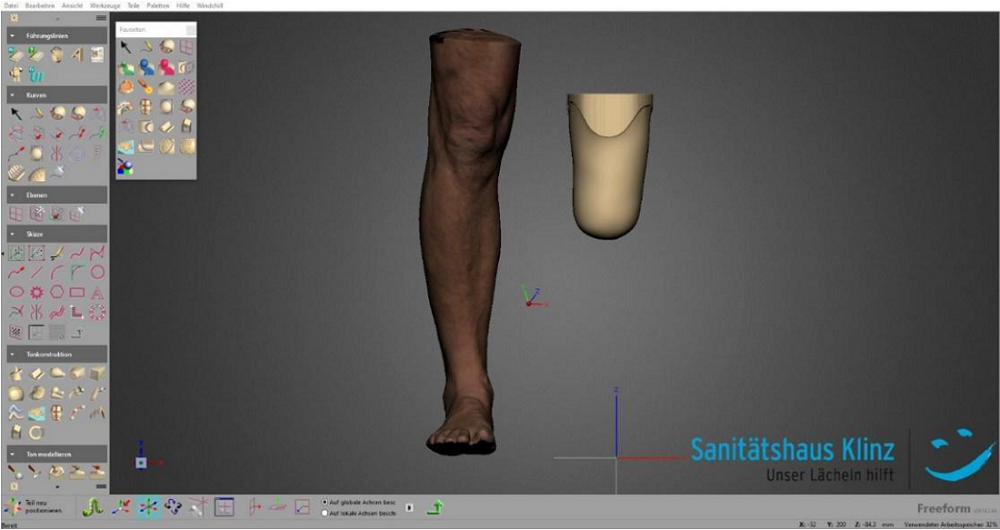
Geomagic Freeform screenshot: an Eva scan of the patient’s contralateral leg & an Eva-scan-based model of his residual leg
Pabst modeled the residual leg in Freeform by mirroring the contralateral leg, then built up and shaped the prosthetic shaft to fit the adapter, shaped the tentacles’ outer dimensions to exactly match the leg’s measurements, and created the suction cups for the tentacles. Then the octopus, shaft, tentacles, and diving helmet were connected, and after another few steps, the design was embossed with Wolfgang’s name and the clinic’s logo.
“The prosthesis was then sent to our 3D printing service provider for production. They made the prosthesis from polyamide (PA2200) using selective laser sintering (SLS), then slide-ground and colored it,” Pabst told me.

Geomagic Freeform screenshot: Shaping the shaft to the adapter, and adapting the design to the prosthesis’ functional elements

Geomagic Freeform screenshot: Shaping the dimensions of the tentacles using the Eva scan measurements of the contralateral leg
All in all, Pabst told me that the modeling and construction took two weeks, and then it was only another week for the 3D printing, coloring, and post-processing to be completed. Because Sanitätshaus Klinz is certified to manufacture custom-made orthotics and prostheses, Pabst told me that “cooperation with any medical partners was not necessary.”
“The manufacturing methods are left to us as long as the process and the materials used comply with the guidelines of the Medical Device Regulation (MDR).”
After the 3D printed exterior components were merged with the design’s mechanical elements in the clinic’s workshop, Wolfgang got to see the new prosthesis for himself when he arrived for his fitting, and he was definitely pleased. The fit is comfortable, and its unique appearance is pretty fascinating when seen in all its glory at the beach.
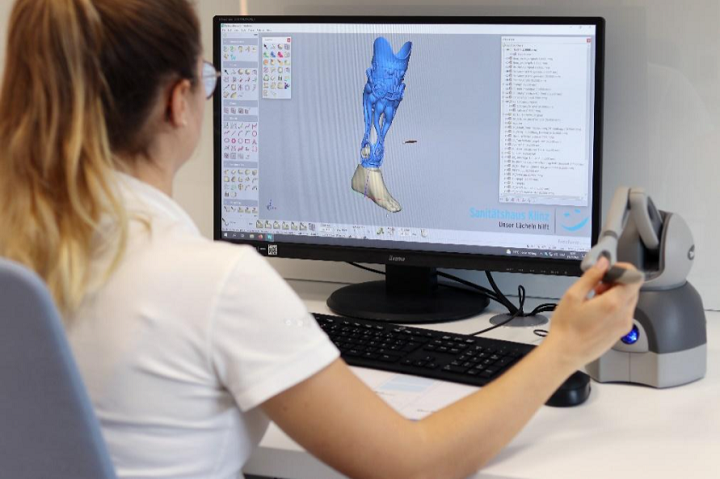
Using a haptic device with Geomagic Freeform to put the finishing touches on the new bath prosthesis
Additionally, Pabst told me that it’s pretty easy to attach and detach the swimming flipper as well:
“Putting on and removing the swim fin on the prosthetic foot is just as easy as putting on shoes on a prosthetic foot. The prosthetic foot is connected to the prosthesis via a special joint. This joint can be locked in two different positions. In order to be able to rotate the foot between the positions, only a split pin has to be loosened and then fastened again.”
Because of the technology’s ability to quickly capture extremely precise, necessary measurements, 3D scanners have made quite the name for themselves in medical applications, helping create foot and neck orthoses and facial and limb prostheses.
“Whenever you need to create an orthosis, or an upper- or lower-body prosthesis, with high-tech or low-tech materials, first you absolutely must have accurate measurements of the patient’s body where the new device will connect,” Pabst concluded in the Artec 3D case study.
“Without this foundation to build on, eventually serious problems will arise, from the fit of the device, to the patient’s physical responses to it, etc. By starting off with Artec scans, every device we produce looks exactly like the other side and a natural extension of their own body. The difference this has made in our work is truly significant.”
Subscribe to Our Email Newsletter
Stay up-to-date on all the latest news from the 3D printing industry and receive information and offers from third party vendors.
You May Also Like
Profiling a Construction 3D Printing Pioneer: US Army Corps of Engineers’ Megan Kreiger
The world of construction 3D printing is still so new that the true experts can probably be counted on two hands. Among them is Megan Kreiger, Portfolio Manager of Additive...
US Army Corps of Engineers Taps Lincoln Electric & Eaton for Largest 3D Printed US Civil Works Part
The Soo Locks sit on the US-Canadian border, enabling maritime travel between Lake Superior and Lake Huron, from which ships can reach the rest of the Great Lakes. Crafts carrying...
Construction 3D Printing CEO Reflects on Being Female in Construction
Natalie Wadley, CEO of ChangeMaker3D, could hear the words of her daughter sitting next to her resounding in her head. “Mum, MUM, you’ve won!” Wadley had just won the prestigious...
1Print to Commercialize 3D Printed Coastal Resilience Solutions
1Print, a company that specializes in deploying additive construction (AC) for infrastructure projects, has entered an agreement with the University of Miami (UM) to accelerate commercialization of the SEAHIVE shoreline...





